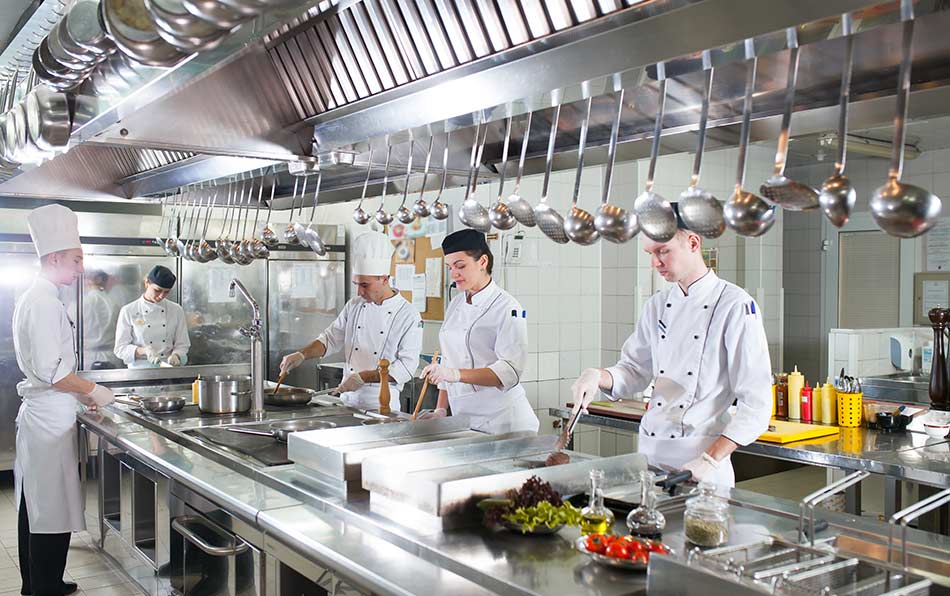If you’ve ever entered a restaurant kitchen, you might’ve heard the Chef shout, “All day!” You might’ve heard the same in popular cooking competitions on TV and in the hit show, “The Bear.”
This term can be a real riddle to figure out, as it’s not as obvious as some other lingo used in kitchens. Working in the culinary industry means you should be aware of this term and all other slang words used in the kitchen environment.
So, why do Chefs say “All day” exactly? And what other kitchen lingo do they use? We’ll explain all of it in this article.
Introduction to Kitchen Lingo
High-pressure working environments often require their own lingo that helps staff members better understand instructions and have a clear idea of what they’re supposed to do.
In fast-paced kitchens, quick communication is key. It’s therefore no surprise that Chefs and other kitchen workers have developed their own slang to help them keep things going.
“All day” is probably the most famous example of this. Although the meaning behind this slang is easy to explain, the same cannot be said for when exactly it originated. Chefs believe some variations of it have existed since the 1880s when restaurants started to boom.
The Meaning of “All Day”
Simply put, the phrase “All day” refers to the total number of orders for a specific dish at a specific time. For example, if table 13 orders two steaks and table 16 orders three steaks, that would be “Five steaks all day”.
One reason people get this term wrong is because it’s actually counterintuitive to what it sounds. “All day” may suggest it’s the number of orders throughout the entire shift (or day), but it actually stands for the number of orders in a particular timeframe.
Why Do Chefs Say “All Day”?
As mentioned above, the reason Chefs say “All Day” is to communicate the total number of a specific dish their team needs to prepare. Instead of calling out each order individually, they combine all active orders to ensure accuracy and efficiency in the kitchen. The phrase also allows Chefs to track cumulative orders in real time.
For example, there are already two orders for a salmon dish and a Server announces another. The Chef will then call out, “Three salmon all day.” If another order for salmon comes in, then it becomes “Four salmon all day,” and so on.
By saying it that way, the Chef combines all the salmon dish orders and ensures everyone knows the exact number of salmon being prepared.
This helps avoid confusion and duplicate calls, and allows everyone in the kitchen to assess whether they have enough ingredients to fulfill all orders.
Other team members usually shout, “Heard” to indicate that they’ve understood the message and are preparing the correct quantity of that particular dish.
“All Day” in Various Dining Settings
While “All day” is a standard phrase across all restaurant kitchens and certain hospitality settings, its usage can vary depending on the type of establishment and the complexity of service.
Casual dining and fast food
In high-volume restaurants, diners, and fast-food kitchens, speed is critical, and “All Day” helps batch orders efficiently. Since multiple customers might order the same item, consolidating these numbers ensures kitchen staff don’t waste time preparing food individually when it can be made in bulk.
- Example: During a busy lunch rush, if Table 3 orders two cheeseburgers and Table 7 orders four, the Expediter will call out, “Cheeseburgers, six all day!” to keep cooks on track.
- Benefit: This system prevents unnecessary repetition, avoids over- or under-prepping, and helps Fry Cooks, Grill Operators and Line Cooks prioritize what needs to be prepared immediately.
Fine dining and upscale kitchens
In fine dining restaurants, where plating precision and timing are essential, “All Day” takes on a more structured role. Orders often arrive in multiple courses, and dishes must be timed so they are served simultaneously to an entire table.
- Example: If a Chef de Partie (aka Station Chef) is preparing steak entrees for different tables, they might hear, “Three filet mignons all day — two medium, one rare.”
- Benefit: This helps Chefs synchronize multiple orders and maintain dish consistency, especially in kitchens where intricate plating and cooking techniques require absolute accuracy.
Additionally, in such high-end establishments, waitstaff and the kitchen use “All Day” to ensure every guest at a table receives their meal at the same time, maintaining an impeccable dining experience.
Bakeries and cafes
Besides traditional restaurant kitchens, you might also hear “All day” when working in coffee shops, bakeries and pastry kitchens. After all these settings typically get high-volume orders that require speed and efficiency.
- Example: A morning rush at a café might have different customers ordering cappuccinos. Rather than processing each ticket individually, the Barista hears, “Four cappuccinos all day!” They can then steam milk accordingly to complete all drinks at once.
- Benefit: This technique reduces redundant effort, speeds up service and ensures orders are fulfilled efficiently, preventing Baristas or Bakers from having to restart prep multiple times for the same item.
Catering and banquets
In large-scale events, weddings and corporate banquets, where dozens or even hundreds of meals need to come out simultaneously, “All Day” is a critical organizing tool for both kitchen and service staff.
- Example: A Chef preparing entrees for a banquet might hear, “40 chicken entrees, 20 vegetarian all day.” This ensures everyone on the kitchen line knows the total amount needed and avoids confusion while assembling plates.
- Benefit: Using “All Day” ensures smooth coordination across different prep stations, whether for plated dinners or buffet-style service. It minimizes errors in high-pressure environments where mass production must still maintain quality and presentation.
The Importance of “All Day” in Kitchen Operations
It’s no secret that restaurant kitchens can be really busy, especially at lunch and dinner times. With so many orders going through the station, clear and efficient communication is essential to keep operations running smoothly and ensure every dish is prepared correctly. This is where “All Day” comes in handy when it comes to kitchen operations.
When the Server comes in with a new order or deposits an order ticket, it’s up to the Chef or their Sous Chef to call out that order to their team in a way that is quick, effective and easy to understand.
In loud and fast-paced kitchens, miscommunication can lead to delays, incorrect dishes and wasted ingredients. That’s why everyone part of the kitchen staff should know the number of orders they’re preparing at that exact moment.

Beyond just being a practical communication tool, Chefs saying “All day” fosters teamwork and a sense of shared responsibility in the kitchen by:
- Encouraging collaboration: When all kitchen staff members hear the same order totals, they naturally start working together to fulfill them efficiently. Line Cooks can coordinate timing, while Prep Cooks can ensure ingredients are ready to meet demand.
- Reducing stress and mistakes: Clear and concise communication minimizes the risk of errors and last-minute scrambles, helping to create a more structured and manageable workflow, even in high-pressure situations.
- Creating sense of team spirit: Calling out “All day” reinforces the idea that everyone in the kitchen is working toward the same goal — that is, delivering quality meals as efficiently as possible. This fosters camaraderie and improves morale, especially in demanding kitchen environments.
See also: 40 Restaurant Positions & Their Descriptions
Other Essential Kitchen Terms
“All day” is just one of the popular slangs that have emerged in restaurant kitchens. If you’re looking for a job as a Cook or Chef, becoming familiar with all kitchen terms is important.
With that said, let’s look at other essential words and phrases you might hear in kitchen settings.
“86”
When an item from the menu has been “86-ed,” it means the kitchen has completely run out of that particular item. It’s used to communicate this problem with the Servers and ensure they take no more orders of that specific item.
“68”
This one typically means that an item is back in stock. However, this term is not as commonly used as “86” and may vary by restaurant. Some restaurants use other codes or verbal cues to indicate when an item is available again.
“Behind”
When working in a kitchen, you might often hear other team members shouting, “Behind!” This indicates that they’re passing behind you and it helps avoid collisions. Safety is critical in kitchen settings and this quick shout ensures no one gets injured.
You can often hear kitchen workers use this shout when carrying a full tray of food or a rack of glassware.
Other variations include “Sharp behind” and “Hot behind,” indicating that another worker carrying a knife, a hot pan or something else that can harm you is passing behind.

“Covers”
In a kitchen setting, “Covers” is used to indicate the number of people being served in the dining room. The number of “covers” helps Chefs and Restaurant Managers determine what the next shift will be like.
It can also be used to make projections for how many orders and ensure there are enough ingredients in the kitchen stock.
“Dead plate”
When a dish has been prepared incorrectly or there’s something else wrong with it, it’s a “dead plate”. This term tells Servers that they shouldn’t take it to customers.
“Dead plates” are sometimes considered fair game for Cooks, Servers and other staff members to eat, but this is usually down to the restaurant’s specific policies.
“In the weeds”
When a kitchen staff member is really busy and has a hard time keeping up, they’ll say they’re “in the weeds”.
This is common in busy kitchens and helps indicate that a staff member cannot take on new tasks at the moment or could use an extra pair of hands if someone is available.
“Mise”
This is short for “mise en place” which is French for “everything in its place”. Cooks and other kitchen staff members use this to indicate that they have finished all the prep work.
The term can also extend to preparing all kitchen equipment such as Chef knives, other utensils, notebooks and similar.
“On deck”
When an order is “on deck” it means that an order is either ready or close to being ready.
For example, when a Waiter/Waitress comes to deposit a new order ticket, the Chef de Partie may tell them that another order is “on deck” and they can take it to customers.
“On the fly”
When you need something “on the fly” it means you need it right away. Staff members often use this when they forget something and then suddenly remember it. “On the fly” indicates that an order is a top priority and needs to be handled as quickly as possible.
You’re most likely to hear this term during peak dining hours when the kitchen staff are preparing so many dishes.
“SOS”
You might think “SOS” is a cry for help in the kitchen, but this term actually means something entirely different. It’s an acronym that stands for “sauce on the side.”
When entering orders into a system or calling them out verbally, “SOS” is a quick and efficient way for Servers and kitchen staff to communicate that a dish should be served without the sauce directly on it.

“Waxing a table”
In restaurants, “waxing a table” means giving a specific table special treatment. It’s used when there’s a VIP guest like a celebrity or a regular customer who is known for tipping well.
You may also hear Servers and other restaurant workers use this term when a food critic arrives at the restaurant.
Adopting Kitchen Lingo as an Aspiring Chef
If you’re getting ready to become a Chef and are looking for Chef jobs, learning the kitchen lingo in advance is a smart move. That way, you’ll know exactly what your team members want to say when they use one of these terms and delivering all of the orders on time will be easier.
After all, this lingo has been introduced for a reason. It’s there to create more efficient communication and ensure all team members are on the same page.
Even if you don’t get something right on day one, you can learn from it and ensure you use the jargon correctly next time.
It’s also a good idea to learn the differences between roles to have a better understanding of everyone’s responsibilities and places in the kitchen hierarchy. For example, Chef and Cook are sometimes used interchangeably but are two entirely different positions.
Why Do Chefs Say “All Day”? – Final Thoughts
Now you know that the phrase “All day” is used to indicate the exact number of orders of one dish at a specific moment. By understanding this and other kitchen lingo we mentioned, you’ll be equipped with everything you need to communicate with kitchen staff efficiently and reliably.
FAQ
The exact origins of “All day” in kitchens are unclear, but it likely comes from the fast-paced nature of professional cooking.
The term is widely used in restaurant kitchens to streamline communication and prevent errors. It ensures that the entire team is aware of the running total of a particular order. This style of communication is common in high-volume kitchens where efficiency is crucial.
In “The Bear” — a TV series about a high-pressure restaurant kitchen — the Chef characters use “All day” to manage orders efficiently. The show accurately portrays the fast-paced nature of restaurant work, where clear communication is essential.
However, the phrase is not unique to the show; it is a real-world term used in professional kitchens.
“SOS” typically means “sauce on the side” in restaurant orders. It tells the kitchen staff to serve sauces separately rather than on the dish.
This is often requested by customers who want to control the amount of sauce they use or have dietary restrictions. It helps ensure customer preferences are met.
No, not all the time. Although Chefs frequently use “All day” in professional kitchens, not all restaurants rely on this term. It is more common in high-volume or fine-dining establishments where precise communication is essential.
Some smaller restaurants or casual kitchens may use simpler phrasing to track orders. Nonetheless, in any fast-paced kitchen environment, “All day” helps streamline workflow and prevent mistakes.




